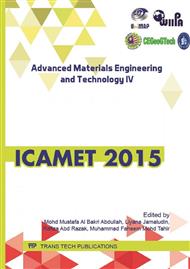p.352
p.358
p.363
p.367
p.373
p.377
p.382
p.388
p.395
Effect of Chromium (II, III) Oxide and Cobalt Oxide on the Colour and Fineness of Cement
Abstract:
The objective of this study is to determine the optimum portions of coloured pigments, chromium (I, II) oxide (Cr2O3) and cobalt oxide in producing coloured cement. The fineness (specific surface area - SS) of coloured cement via Blaine permeability test is also determined. The green and grey colours become darker as the percentages of chromium (II, III) oxide and cobalt oxide are increased. The chromium (II, III) oxide coloured cement become coarser as the added portions of chromium (II, III) oxide pigment is increased from 3 to 9 %. For cobalt oxide coloured cement, it becomes finer as the added portions of the cobalt oxide pigment are increased from 3 to 6 %. Results show that the optimum portions of chromium (II, III) oxide and cobalt oxide being added into the white cement in order to produce the colours at the most best is 5%. The Blaine permeability test shows that the values of the specific surface of the coloured cements comply with the Standard Specification.
Info:
Periodical:
Pages:
373-376
Citation:
Online since:
May 2016
Authors:
Price:
Сopyright:
© 2016 Trans Tech Publications Ltd. All Rights Reserved
Share:
Citation:


